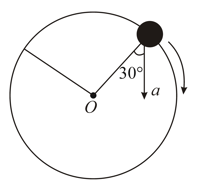EASY
NEET
IMPORTANT
Earn 100
A gramophone record is revolving with an angular velocity . A coin is placed at a distance from the centre of the record. The static coefficient of friction is . The coin will revolve with the record if
(a)
(b)
(c)
(d)
50% studentsanswered this correctly

Important Questions on Circular Motion
EASY
NEET
IMPORTANT
A car of mass negotiates a banked curve of radius on a frictionless road. If banking angle is , the maximum speed of car is
EASY
NEET
IMPORTANT
A car of mass is moving on a level circular track of radius . If represents the static friction between the road and tyres of the car, the maximum speed of the car in circular motion is given by
MEDIUM
NEET
IMPORTANT
Two stones of masses and are whirled in horizontal circles, the heavier one in a radius and the lighter one in radius . The tangential speed of lighter stone is times that of the value of heavier stone when they experience the same centripetal force. The value of is,
HARD
NEET
IMPORTANT
A car is negotiating a curved road of radius . The road is banked at an angle . The coefficient of friction between the tyres of the car and the road is . The maximum safe velocity on this road is
EASY
NEET
IMPORTANT
In the given figure, represents the total acceleration of a particle moving in the clockwise direction in a circle of radius at a given instant of time. The speed of the particle is

MEDIUM
NEET
IMPORTANT
A particle starts with angular acceleration . It moves in a random interval of . Find out the time at which random interval starts.
EASY
NEET
IMPORTANT
One end of the string of length is connected to a particle of mass and the other end is connected to a small peg on a smooth horizontal table. If the particle moves in a circle with speed , the net force on the particle (directed towards the centre) will be ( represents the tension in the string)
MEDIUM
NEET
IMPORTANT
A wheel has a constant angular, acceleration of . During a certain interval, it turns through an angle of . Assuming that at , angular speed how long, is motion at the start of this interval?
